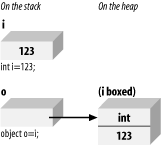Boxing and Unboxing Types
Boxing and unboxing are the processes that enable value types (e.g., integers) to be treated as reference types (objects). The value is “boxed” inside an Object and subsequently “unboxed” back to a value type. It is this process that allowed you to call the ToString( ) method on the integer in Example 6-4.
Boxing Is Implicit
Boxing is an implicit conversion of a value type to the type Object. Boxing a value allocates an instance of Object and copies the value into the new object instance, as shown in Figure 6-4.

Figure 6-4. Boxing value types
Boxing is implicit when you provide a value type where a reference is expected. The compiler notices that you’ve provided a value type and silently boxes it within an object. You can, of course, explicitly cast the value type to a reference type, as in the following:
Dim myIntegerValue As Integer = 5 Dim myObject As Object = myIntegerValue ' explicitly cast to object myObject.ToString( )
This is not necessary, however, as the compiler will box the value for you, silently and with no action on your part:
Dim myIntegerValue As Integer = 5 myIntegerValue.ToString( ) ' boxed for you
Unboxing Must Be Explicit
To return the boxed object back to a value type, you must explicitly unbox it if Option Strict is On (as it should be). You will typically unbox by using the DirectCast( ) function or the CType( ) function. Figure 6-5 ...
Get Programming Visual Basic .NET, Second Edition now with the O’Reilly learning platform.
O’Reilly members experience books, live events, courses curated by job role, and more from O’Reilly and nearly 200 top publishers.

